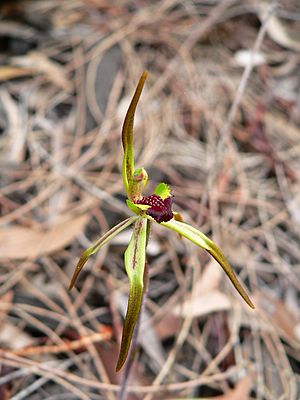Small bayonet spider orchid facts for kids
Quick facts for kids Small bayonet spider orchid |
|
|---|---|
 |
|
| Conservation status | |
| Scientific classification | |
| Genus: |
Caladenia
|
| Species: |
gladiolata
|
| Synonyms | |
|
|
The Small Bayonet Spider Orchid (Caladenia gladiolata) is a special type of orchid plant. People also call it the Smelly Socks Orchid or just Bayonet Orchid. This plant only grows naturally in South Australia, which means it's endemic there. It's a ground orchid, meaning it grows in the soil, and has a single fuzzy leaf. Its flowers are usually yellowish or brownish with red stripes. They have unique tips on their petals and sepals.
Contents
What Does the Small Bayonet Spider Orchid Look Like?
The Small Bayonet Spider Orchid is a plant that grows from an underground part called a tuber. It's a perennial plant, meaning it lives for more than two years. It also loses its leaves each year, which makes it deciduous.
Leaves and Flowers
Each orchid has one hairy leaf, which is about 30 to 80 millimeters (1.2 to 3.1 inches) long and 6 to 12 millimeters (0.2 to 0.5 inches) wide. The plant grows one or two yellowish-green or brownish flowers on a stem that can be 40 to 150 millimeters (1.6 to 5.9 inches) tall. These flowers have red marks and a strong, spicy smell.
The sepals and petals of the flower have thick, flat tips that look like a bayonet, which is a type of knife. These tips are about 5 to 12 millimeters (0.2 to 0.5 inches) long and curve downwards. The top sepal stands up straight and curves forward. It is about 15 to 30 millimeters (0.6 to 1.2 inches) long. The side sepals are also 15 to 30 millimeters long, and the petals are 12 to 20 millimeters (0.5 to 0.8 inches) long.
The Labellum
The labellum is a special part of the orchid flower that often looks like a lip. For this orchid, the labellum is egg-shaped, about 9 to 11 millimeters (0.35 to 0.43 inches) long and 8 to 9 millimeters (0.31 to 0.35 inches) wide. Its end curves downwards. The labellum is yellowish-green with a red tip. It usually has a few short teeth along its edges. There are also four rows of small, club-shaped, reddish-black bumps called calli along the center of the labellum. This orchid blooms from July to October.
How Was the Small Bayonet Spider Orchid Named?
The Small Bayonet Spider Orchid was first officially described in 1907 by a scientist named Richard Sanders Rogers. He published his description in a scientific journal. The plant's scientific name, gladiolata, comes from the Latin word gladius, which means "a sword." This name likely refers to the sword-like tips on its sepals and petals.
Where Does the Small Bayonet Spider Orchid Live?
This special orchid grows in certain areas of South Australia, including the Flinders Ranges and the Northern and Southern Lofty regions. It prefers to grow in woodlands and forests where the soil drains well. Sadly, this orchid is quite rare. Scientists currently know of only three or four groups of these plants still living in the wild.
Why Is This Orchid Endangered?
The Small Bayonet Spider Orchid is listed as "endangered" by the Australian Government. This means it is at a very high risk of disappearing forever.
Threats to the Orchid
There are several reasons why this orchid is in danger:
- Weed Invasion: Other plants, called weeds, can grow too close to the orchids and take away their space, water, and nutrients.
- Grazing: Animals eating the plants can also harm the orchid populations.
- Lack of Pollination: The orchid needs specific insects to help it reproduce by carrying pollen. If these insects are not around, or if their numbers are low, the orchids cannot make seeds.
Protecting these orchids is important to make sure they continue to be a part of Australia's unique plant life.


